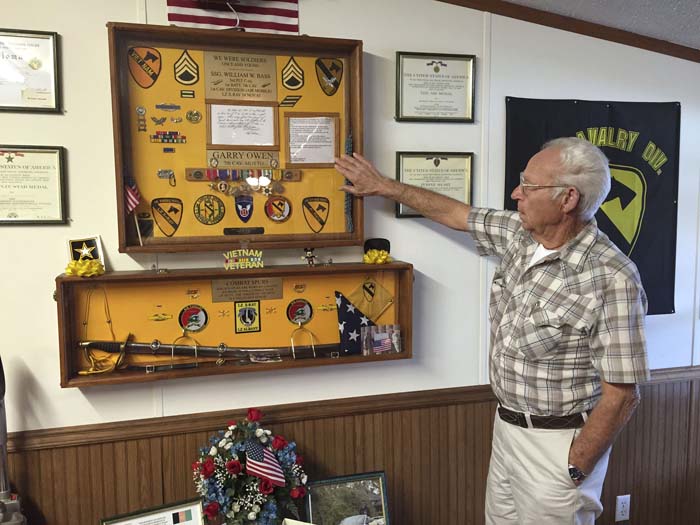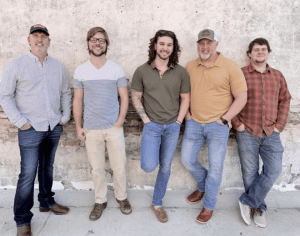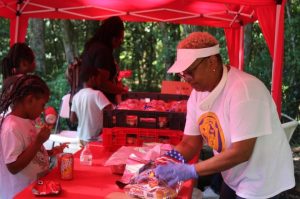Local men fought in most fierce Vietnam War battle
Published 5:18 pm Friday, November 13, 2015

- William Bass’ children created this “Wall of Honor” him. Bass (pictured) said the items had stayed packed until a few years ago. Bass’ most prized possession, above the medals and ribbons, is a letter from his daughter.
THOMASVILLE — World War II had Normandy. Iraq had Fallujah. Vietnam had Ia Drang Valley.
Two local men, Carl Palmer and William Bass, were in the middle of the Vietnam War’s most savage and significant battle exactly 50 years ago today.
Trending
Fleeing poverty in his hometown of Barwick, Bass volunteered for service in the Army. He was assigned to the 1st Battalion of the 7th Calvary, George Custer’s historic regiment. Custer was an American Army general who famously led his men to a massacre at the Battle of Little Bighorn 89 years before the Vietnam War.
Palmer, a 39-year-old resident of Pelham at the time and a veteran of the Korean War, was a platoon sergeant in the same battalion, although the two men did not know each other.
“This was the best and most well trained and conditioned unit that ever went into battle,” Bass said. “Col. Hal Moore saw to that. I had all the respect in the world for Moore.
“Even in training in Fort. Benning, he would get out there with us.”
At the time, Bass was a 23-year-old E-5, commonly known as a buck sargeant.
“The colonel was in the thick of things with us,” he said. “He had a lot of combat experience.”
Trending
The 7th Calvary was deployed from Fort Benning, near Columbus, to Vietnam in August 1965.
“We knew where we were going,” Bass said, “Hal told us that we were going out to find them (the North Vietnamese army) and we did, always.”
On Nov. 14, 1965, Palmer, Bass and the rest of the 450 men of the 1st Battalion, 7th Calvary climbed into helicopters and were dropped into a small landing zone (LZ) that Moore had named X-ray, in the Central Highlands of Vietnam in the Ia Drang Valley.
The Vietnam War marked the first time helicopters were used extensively to transport troops and supplies to the battlefield. The 1st Calvary was one of, if not the very first, to train and utilize this method.
Bass saluted the “chopper pilots.”
“We landed only one time in the LZ, but the chopper pilot has to land several times,” he said. “Capt. Ed ‘Too Tall To Fly’ Freeman and other pilots like him risked everything to bring these soldiers supplies and reinforcements.”
The pilots also took out the wounded.
According to the book We Were Soldiers Once…and Young, Moore knew there was a major enemy presence at the base of the Chu Pong Massif but had no way of knowing his troops were about to face two regiments of North Vietnamese regulars — more than 3,000 very good soldiers.
“This was the first battle, first real contact we had made,” Bass said. “We had been on small missions, but nothing like that, nothing major.”
Palmer was a member of Capt. John Herren’s Bravo Company. The unit was one of the first to hit the ground. Palmer’s platoon was under the command of a green lieutenant, Henry Herrick, who Palmer had warned Herren would “get us all killed.”
Soon after hitting the battlefield, Herrick spotted enemy troops and his platoon set off in hot pursuit, running right into 150 North Vietnamese troops. His platoon was surrounded and became the infamous “Lost Platoon” of the Ia Drang Valley battle.
During the fighting on the second day, Herrick was killed and command was passed to Palmer. Within minutes of taking over, Palmer was shot in the head, but not fatally. He was bandaging his head and making plans to get his men out when a hand grenade was thrown. It went off right behind him, killing him.
Command ultimately fell to Ernie Savage, who led the platoon through the rest of the battle. At the end of that first day, eight of the platoon’s 27 men were dead. Twelve were wounded.
As the battle heated up that first day, survival was utmost in Bass’ mind. He said, “After we landed in Ia Drang Valley, my hopes of ever coming home were over.”
While Bravo was under attack, the Charlie Company (C Company) was also facing fierce fighting, with the first two platoons being overrun.
“When the 1st and 2nd platoons (of C Company) were overrun, some of those boys on the left flank died with personal contact with the enemy,” Bass said. “They were all killed in action or wounded bad, severely. I was on the right flank at the LZ, a very small place. I was in the C Company, third platoon, right flank.
“After the 1st and 2nd platoon was overrun, I took everything out of my wallet and destroyed it. What’s going to happen to my son? That was my major concern. If I got killed — I had no intention of being captured — the enemy couldn’t get anything. I did that to keep (my personal items) from being scattered all over. I had a picture of my wife and kid. I destroyed anything of any benefit to anyone but me.
“What I saw and what the man next to me saw are two different things. You can see what’s happening in front of you. Ain’t like you can look around you. There are so many things going on that you don’t know. I didn’t know what was going on in Col. Moore’s position and his position was 50 yards from me. I couldn’t see others in my platoon 10 yards away. Too dense, you can’t see through the (elephant) grass.
“When in a fire fight like that, you are trying to get below ground,” Bass continued with a little laugh, “If you stood up, you got killed. But if you stood up, you could see what’s going on around you. But durn, honey, you aren’t going to get up.
“There was a little ol’ tree we hid behind, Sgt. Clyde Hewitt and I. We’d lay there and if we moved our feet, a round would come right over. Hewitt would say, ’Bass, where is he?’ and I’d ask ‘Hewitt, you see him?’ ‘No.’ We shot in his area long enough he either went away or died.”
Bass was C Company’s 3rd squad leader.
He said, “We had people on our left and right. People were staggered. We were in the center of my squad. We weren’t isolated by any means.”
Bass fondly remembers a large African American man he fought with, Douglas Gist.
“I’m a little fella. He’s a big fella. He was my machine gunman on my right front. He got shot,” Bass recalled. “I couldn’t walk him out. I put a rope under his arms, around his back. A 140-pound man pulled a more than 200-pound man 90 feet to safety by putting a rope around his shoulders. Imagine that,” he said with a shake of his head.
“The first night, we fought all night long using daytime tactics because of the flares. That many (enemy soldiers) you couldn’t fight off. They would have overpowered us without support from the artillery and air.”
Bass carried into battle an M-16 rifle, three canteens and a little butt pack.
“I had 200 to 250 rounds of ammunition with me. That much ammo let me fight for a while,” he said. “They couldn’t get to us to relieve us, couldn’t get support. We ran low in ammunition. Ran out of water and didn’t care about the food. The main thing was water.”
Bass said several Americans got killed trying to get to the water when it arrived.
He explained. “The 1st Calvary didn’t have any ground vehicles. All supplies came off the whirly bird. If they couldn’t get a chopper in, they couldn’t bring us anything.”
On the second morning, the entire LZ was in grave danger of being overrun.
Bass said, “I’m durn proud Moore called ‘Broken Arrow’ (the code words for an American unit in trouble).”
Once that call went out, Moore’s unit received air support from all available air craft in South Vietnam.
U.S. Air Force Sgt. Charles Darnell, who currently lives north of Tallahassee, Florida, remembers loading everything they had onto every plane they had.
“I have never loaded as many bombs as we did that day,” he said.
Bass said, “The Air Force had them planes stacked up layer after layer after layer. We were so heavily outnumbered, if we hadn’t had superior fighter power we would not have survived. We couldn’t have survived that.”
Palmer said a C-130 dropped ammo to the troops.
“It couldn’t land,” Bass remembered, “but that was a beautiful thing. We had gotten low, very low.”
Stan Alligood of Meigs was a supply clerk at the unit’s base camp. He remembers the order to send 100 tons of artillery shells and “all the body bags we had.”
Extra artillery was also dropped in by helicopter several miles from the valley.
Barkley Hanna of Thomasville doesn’t know if he was involved in the Ia Drang Battle for sure or not, but he remembers that the infantry was being overcome in the fall of 1965 in the Central Highlands of Vietnam. He said he and the rest of the 19th Field Artillery fired their 38-pound bombs from Howitzers all day and all night in support of the troops. The Howitzers could fire from seven miles away.
“If it hadn’t been for the Air Force and artillery, we would be up there talking to Custer,” Bass said with a laugh and a bounce of his shoulders.
Bass and his men spent almost three days on their bellies, in battle before they got relief and were airlifted out of there.
“When I think of that battle, I think of Custer,” said Bass. “We joked about it. We almost went the way of Custer.
“The reason we didn’t was because of the Air Force and artillery and our will to fight,” he continued, shaking his fist. “Take any of those away it and it’s done.
“In my platoon, we probably lost six men. The other platoons were severely wounded or dead.”
Bass attributes being alive today on not being in the wrong place at the wrong time.
“The enemy doesn’t know who is who,” he said. “It doesn’t mean you’re any better than the other, just not in the wrong place at the wrong time. If you believe in luck, you can say its luck.”
According to reporter Joseph Galloway, who was at the battle, C Company lost all its officers and all but 45 men after the second day of fighting.
“We lost our platoon leader. Lt. William Franklin got shot up. He survived, but he was badly wounded,” Bass said.
According to Galloway, after three days and two nights of fighting, Moore’s “battalion and attachments had lost 79 killed and 121 wounded. The enemy had lost an estimated 1,300 dead. Approximately 400 American sorties had been flown … artillerymen … had fired 3,000 2.75-inch rockets.”
“It was kind of a rough ordeal,” said Bass. “It was the worst, but there were other battles almost as bad. That one was the hardest.
“Honestly, I can’t even imagine going through it. There is not a day that goes by that that (battle) is not front and center in my mind.
“No, it don’t get no easier. Sometimes I break down. I hate to break down. You don’t ever forget it. The thing that wears the hardest is the people of this country don’t appreciate it.
“We’re decent human beings. I was doing what I was told to do … done what I pledged to do. If they think I enjoyed it, I did not.
“I think about the men lost and how lucky I am today and I grieve for the ones that didn’t make it.”






